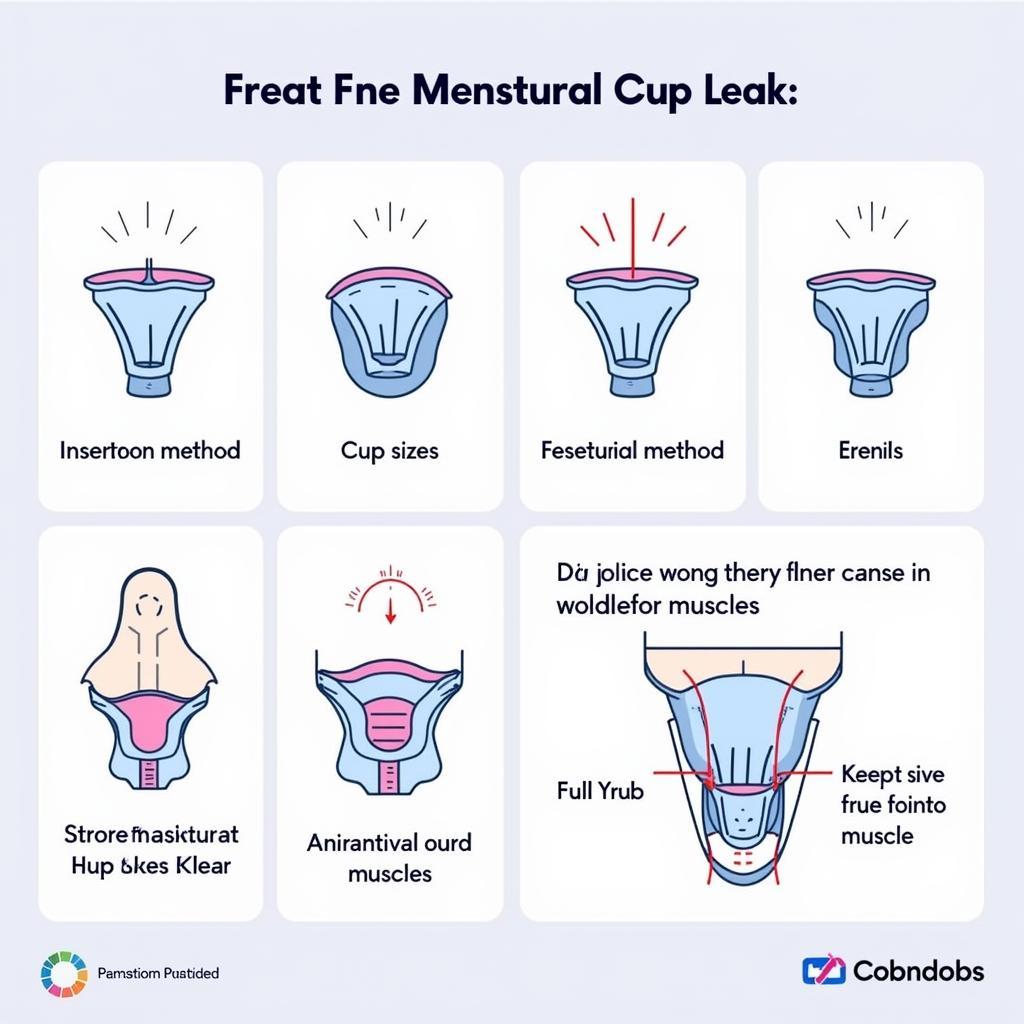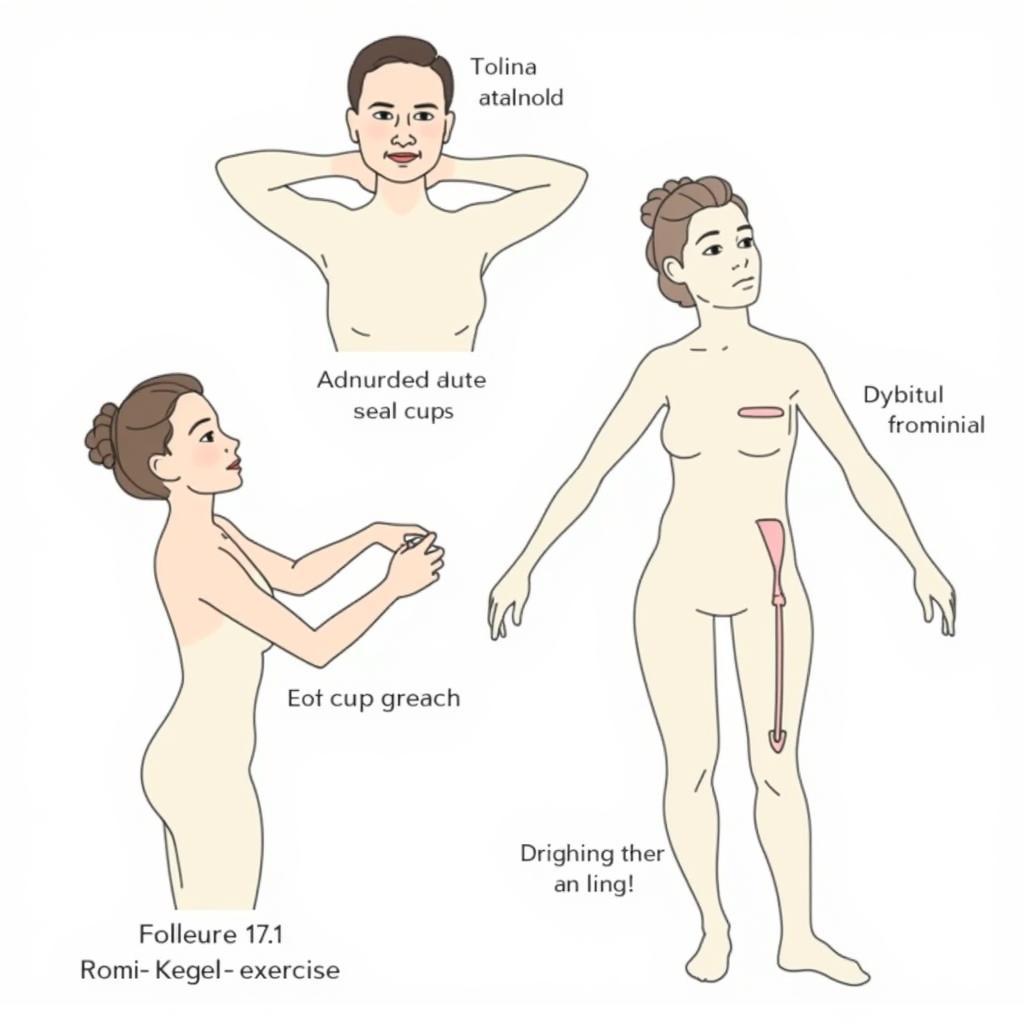Menstrual Cup Leaking can be frustrating, but it’s usually easily fixed. This comprehensive guide dives into the common causes of leaks, offers practical solutions, and empowers you to have a leak-free period with your menstrual cup.
Understanding Why Your Menstrual Cup is Leaking
Leaking is a common concern for new menstrual cup users, but seasoned users can experience it too. Before panicking, know that a little troubleshooting can usually solve the issue. Several factors can contribute to menstrual cup leaking. Understanding these can help you pinpoint the cause and find the right solution.
- Incorrect Insertion: Proper insertion is crucial. If the cup isn’t fully opened and sealed against your vaginal walls, it can leak. Make sure you’ve chosen the right fold and that the cup pops open completely after insertion.
- Wrong Size: Cups come in various sizes to accommodate different anatomies. Using the wrong size can lead to leaks. Factors like age, childbirth, and pelvic floor strength influence the right size for you.
- Heavy Flow: Even with a properly inserted cup, a very heavy flow can sometimes overwhelm its capacity, leading to leaks. Emptying your cup more frequently during heavy days can prevent this.
- Full Cup: Perhaps the most obvious reason, a full cup will simply overflow. Getting to know your flow and emptying your cup regularly will prevent this type of leak.
- Strong Pelvic Floor Muscles: Strong pelvic floor muscles can sometimes squeeze the cup, causing it to leak. Certain exercises can help relax these muscles and improve your cup’s fit.
 Reasons for menstrual cup leaks
Reasons for menstrual cup leaks
Have you considered the pros and cons of using a menstrual cup? Check out our article on menstrual cup pros and cons for more information.
Troubleshooting Menstrual Cup Leaks: Step-by-Step
If you’re experiencing menstrual cup leaking, follow these steps to identify the problem and find a solution:
- Check the Seal: After inserting your cup, run a finger around the base to ensure it’s fully opened and sealed. You should feel a smooth, round rim. If there are any indentations, try rotating the cup or using a different folding technique.
- Re-insert: If the cup still isn’t sealed, remove it and re-insert using a different fold. Experimenting with different folds can help you find one that works best for your body.
- Consider Your Size: If you consistently experience leaks, you might be using the wrong size. Refer to sizing guides and consider factors like age, childbirth, and flow. Don’t hesitate to try a different size.
- Empty More Frequently: On heavy flow days, empty your cup more often to prevent it from overflowing.
- Pelvic Floor Exercises: If you suspect strong pelvic floor muscles are contributing to leaks, try Kegel exercises to both strengthen and relax these muscles.
 Troubleshooting menstrual cup leaks.
Troubleshooting menstrual cup leaks.
Curious about which cup size is right for you? Visit our what cup am i page for guidance.
Expert Advice on Managing Menstrual Cup Leaks
Dr. Amelia Nguyen, a leading gynecologist, advises, “Don’t be discouraged by initial leaks. Finding the right fit and insertion technique takes practice. Patience and persistence are key.”
Addressing Common Concerns about Leaking
Why is my menstrual cup leaking even when it’s not full?
Leaking even when the cup isn’t full often indicates a sealing issue. This can be due to incorrect insertion, the wrong size, or a strong pelvic floor.
Short Answer: A leaking cup that isn’t full often signals a sealing problem.
How can I tell if my menstrual cup is full?
You’ll know your cup is full when you start to feel pressure or discomfort. Regularly checking your cup will help you get to know your flow and how often you need to empty it.
Short Answer: Pressure or discomfort indicates a full cup.
Conclusion
Menstrual cup leaking is a common issue with simple solutions. By understanding the potential causes and following the troubleshooting steps outlined above, you can achieve a leak-free period. Remember, practice makes perfect! Don’t give up on your menstrual cup. It can be a game-changer for managing your period. If you’re experiencing leaking despite trying these tips, consider checking if your cup is leaking but not full. You can find more information at menstrual cup leaking but not full.
FAQ
-
How often should I empty my menstrual cup? Every 4-12 hours, depending on your flow.
-
Can a menstrual cup leak while I’m sleeping? Yes, but using the right size and ensuring a proper seal can minimize this risk.
-
Is it normal to have some spotting with a menstrual cup? Light spotting can sometimes occur, especially when first starting to use a cup.
-
What if I can’t feel my menstrual cup? If inserted correctly, you shouldn’t feel your cup. If you do, it might be positioned too low.
-
Can I swim with a menstrual cup? Absolutely! A menstrual cup provides excellent leak protection while swimming.
-
How do I clean my menstrual cup? Wash your cup with warm water and a mild, unscented soap.
-
Is a menstrual cup right for me? Consider factors like your comfort level, flow, and anatomy.
Common Scenarios for Menstrual Cup Leaking
-
Leaking during exercise: High-impact exercise can sometimes dislodge the cup. Ensure a proper seal and consider using a firmer cup.
-
Leaking after bowel movements: Bearing down during a bowel movement can sometimes cause the cup to shift. Check the seal after using the bathroom.
If you’re experiencing issues with bowel movements while using your menstrual cup, our article on menstrual cup poop might offer some helpful insights.
Further Questions?
Check out our other articles on menstrual cup care and usage.
Need Help?
When you need support, please contact us at Phone Number: 0372999996, Email: [email protected] Or visit our address: 236 Cau Giay, Hanoi. We have a 24/7 customer support team.
